BRUTAL CONCRETE AND GREEN TEA
- Frederick Rickmann

- 2021年11月22日
- 讀畢需時 3 分鐘
Date: June 3, 2015

Renewing our cities can take really many forms. Old buildings can be torn down and some of the more outstanding ones can be rebuilt. Whole areas can be cleared and then stand vacant for years. The old Central District of Taichung city once used to be called "Little Kyoto" because of its charm. But today, the word "charm" would hardly be an appropriate adjective. Years of commercial despair and planning neglect have left this area a ghost of its former self. Unfortunately it is not an uncommon problem for many global cities.

The challenge with this district is that the buildings were once all reasonably good architecture without being brilliant. Somehow they worked together as a whole, but individually they are not particularly special. However new types of development and design are bringing new architectural qualities and commercial success to the area.

If you want to have a great snack or to dine really well you can't do much better than to go to the 4th Commercial Savings Bank. That was the former use when the bank opened in the 60's. The financial crisis brought ruin and bankruptcy to that institution and the building fell into heavy disrepair. The renaissance of the address is however complete with a café and restaurant complex that retains the old original name. It retains also many of the details of the bank. The original teller counters are there for serving ice cream delicacies and the old vault door is used once again on the street elevation. The intrinsic quality of the atmosphere comes from blending an oriental delicacy of touch with the raw brutalism of the exposed original concrete structure.

The interesting aspect is that the Taiwanese interior designers are keeping the characteristics of the former use and using them in a new way. So the old buildings are not just retained in their basic structure - but many furnishings and details are renewed and reused. The effect is that the customers are now flocking to the old/new buildings. And underlining the fact that effective city planning is a partnership between innovative economics and dynamic bold architecture.

A similar project, Miyahara, took the ruin of the old Japanese Eye Clinic building which has dominated an important corner location on one of the rivers in this district. The old clinic had originally been erected during the Japanese colonial period but for decades had stood without an effective roof or any maintenance at all. Now a total rebuilding and retention of the old fabric of the brickwork and remaining timbers has resulted in an amazing building experience - which creates queues of customers and visitors blocking the surrounding sidewalks.

It is inspiring to see tourists congregating outside a cake shop and restaurant to take photographs. Yet the careful rebirth of the building is seen somehow as a symbol of the rebirth of the Orient. Here there are Japanese tourists admiring their past architecture standing shoulder to shoulder with Chinese tourists who see a new modern interpretation of Chinese aesthetics. And they are all mixed together with the locals who just want a good cup of fine mountain spring tea and a moon cake.

More details are on page 167 of “BLUE and other shapes 2”.
#MiyaharaTaichungTaiwan #The4thCreditCooperative #LittelKyoto #ChineseAesthetics #BrutalConcrete #InnovativeEconomics #MoonCake #宮原眼科 #第四信用合作社 #小京都 #創新經濟學 #太陽餅 #CityPlanning #TheGreenGoodDesignAward #iFDesignAward #architect #FrederickRickmann #AFR #ThinkingUrban #70MEDiA #DNgroup #1234Design #Denmark #arkitekt #Danmark #建築事務所 #出版社 #帝山諾 #丹麥設計 #デンマークのデザイン



留言